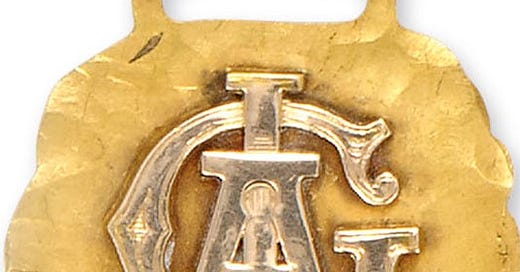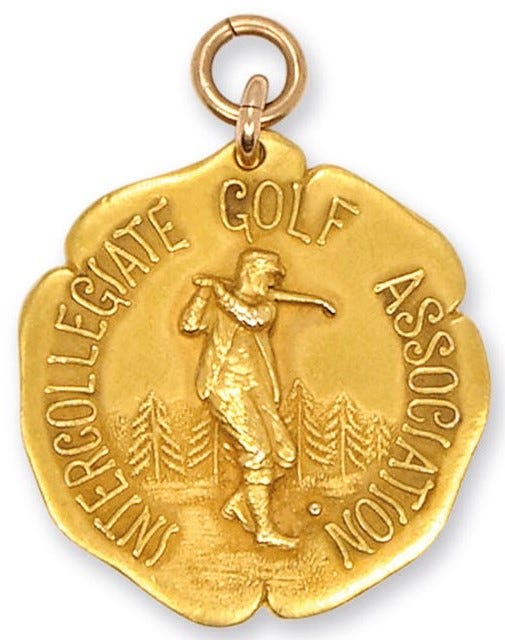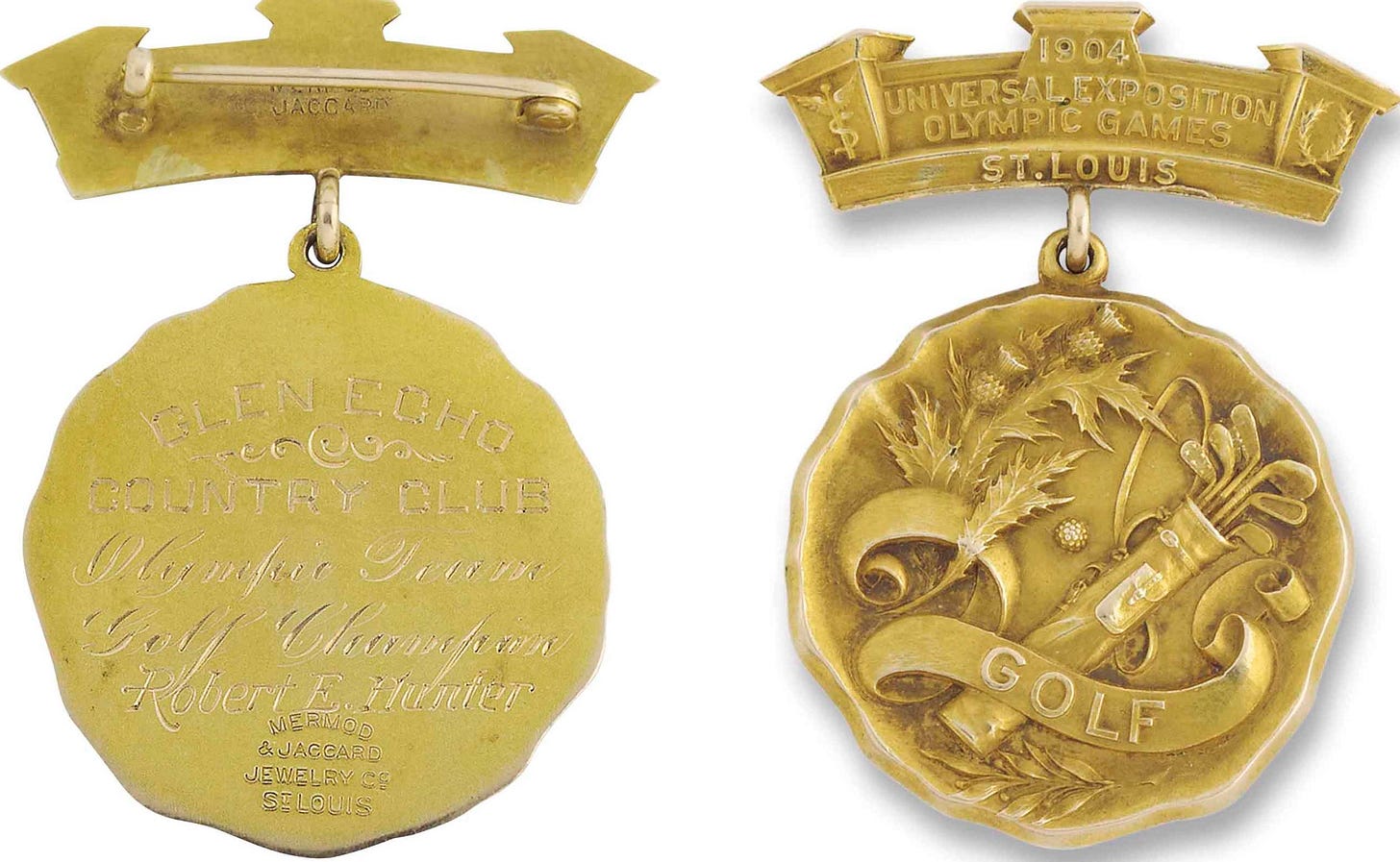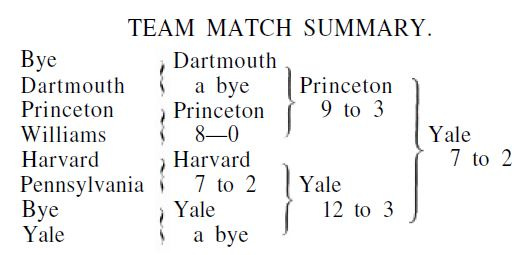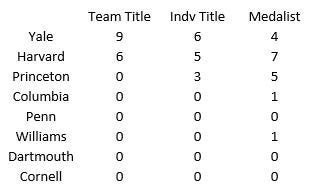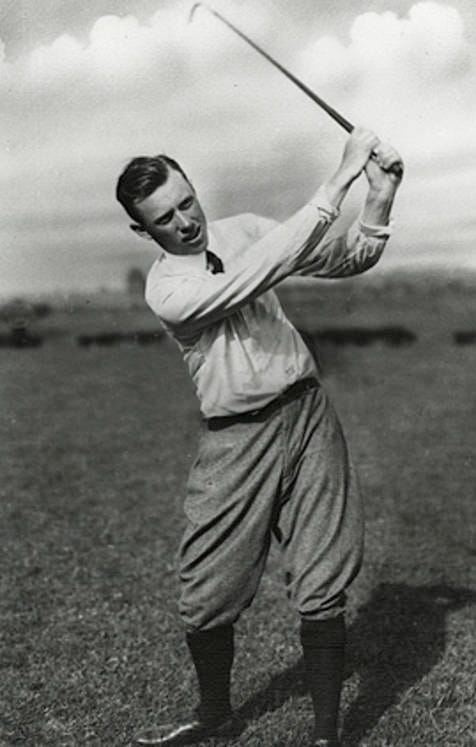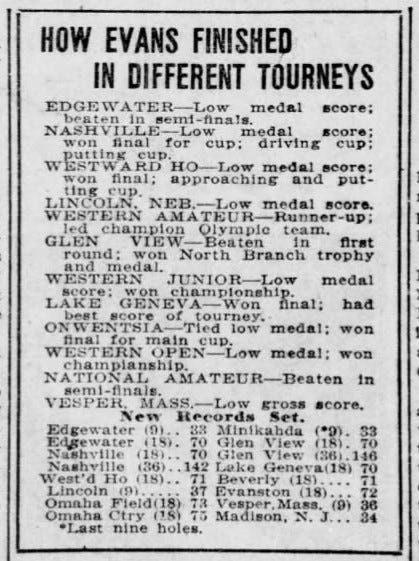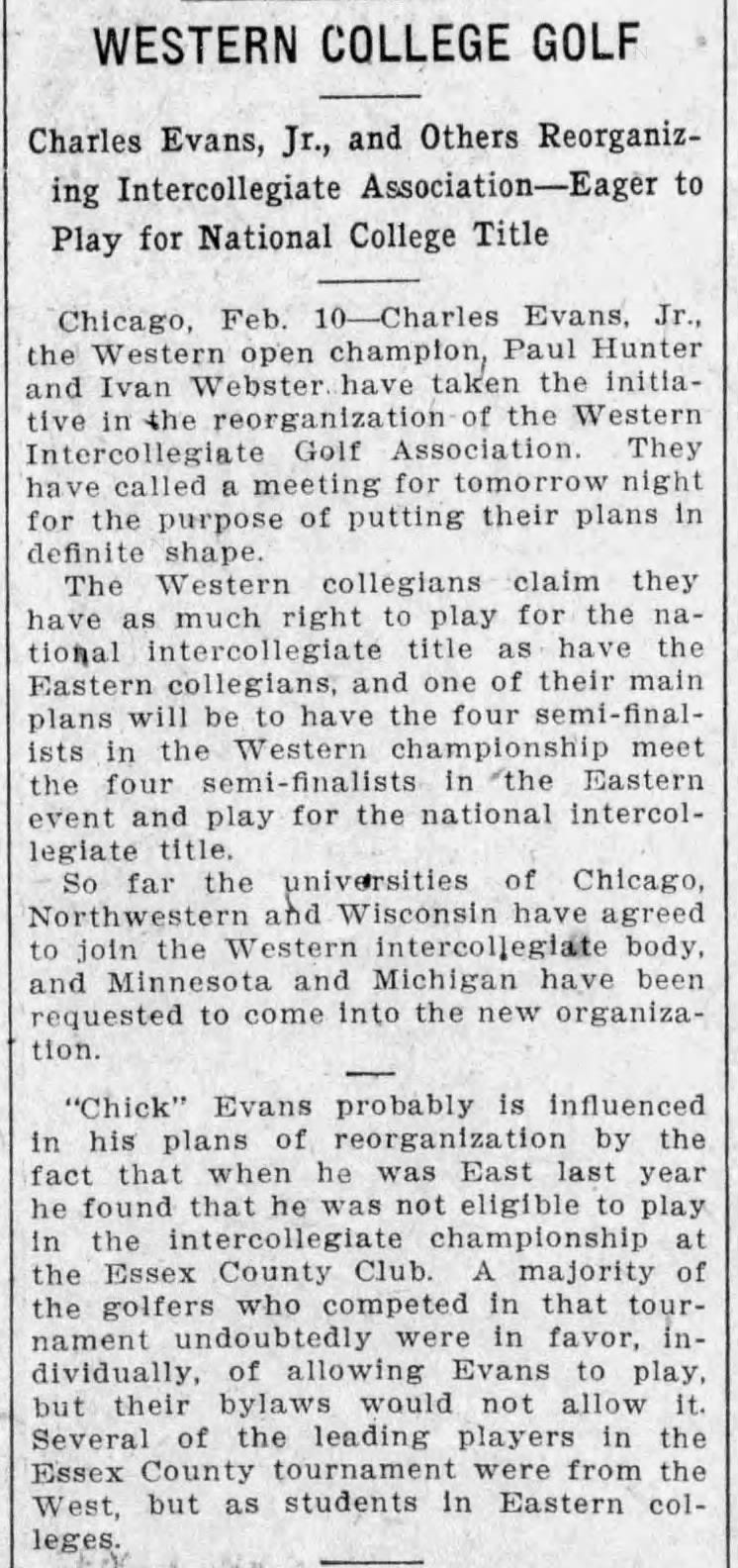This is part of a series on the Men’s Collegiate Championships
IGA Championship Era: 1897-1938
These incredibly cool IGA medals from the 1909 and 1910 championships went up for auction in 2015 along with several other medals and trophies won by Yale’s Robert E Hunter. These are some of the earliest (known) surviving medals and are an excellent example of the fact that the design was not yet standardized.
Recall that Hunter, from the “Western” Chicago area, is not new to big time competitive golf. In fact, the man had earned a team Olympic medal SIX years prior!
Intercollegiate Championship #15: Sep 19-24, 1910
Moved to September to avoid interference with school studies, the IGA championship dates were switched from BEFORE the US Amateur (Sep 5th) to AFTER (Sep 19th). The US Am was hosted by The Country Club in nearby Brookline.
Host: Essex CC (Manchester, MA)
Format
Team match play (6 teams, 6 players each, random draw)
Morning singles, afternoon fourball
Individual stroke play qualifier (18 holes)
Individual match play (16 players, random draw, 18 hole matches)
Results
Team Champ: Yale (9)
The Yale team seeking their SIXTH STRAIGHT title is easily the favorite with an incredible squad that included Robert Gardner (recent 1909 US Am champ playing in his first IGA championship), captain BP Merriman, Karl Mosser, George Stanley (who would win the individual title next year), HG Legg (last year’s runner-up and twice defending Minnesota and Trans-Mississippi champ), and the aforementioned Robert Hunter. While these names might not ring through history, they were certainly heavy hitters at the time; if the 1904 Harvard team was like the infamous 1927 Yankees “Murderer’s Row” then this Yale team would be the 1929-31 Philadelphia Athletics. Arguments of best team ever aside, Yale rolled straight through the tournament, both matches being decided by the time the morning singles were won - a fact which was noticed and led to the switching of the singles and four-ball sessions in championships going forward. The most interesting match of the tournament came in the Finals when the reigning US Am champ (Yale’s Gardner) defeated the reigning IGA individual champ (Princeton’s Seckel) 2&1.
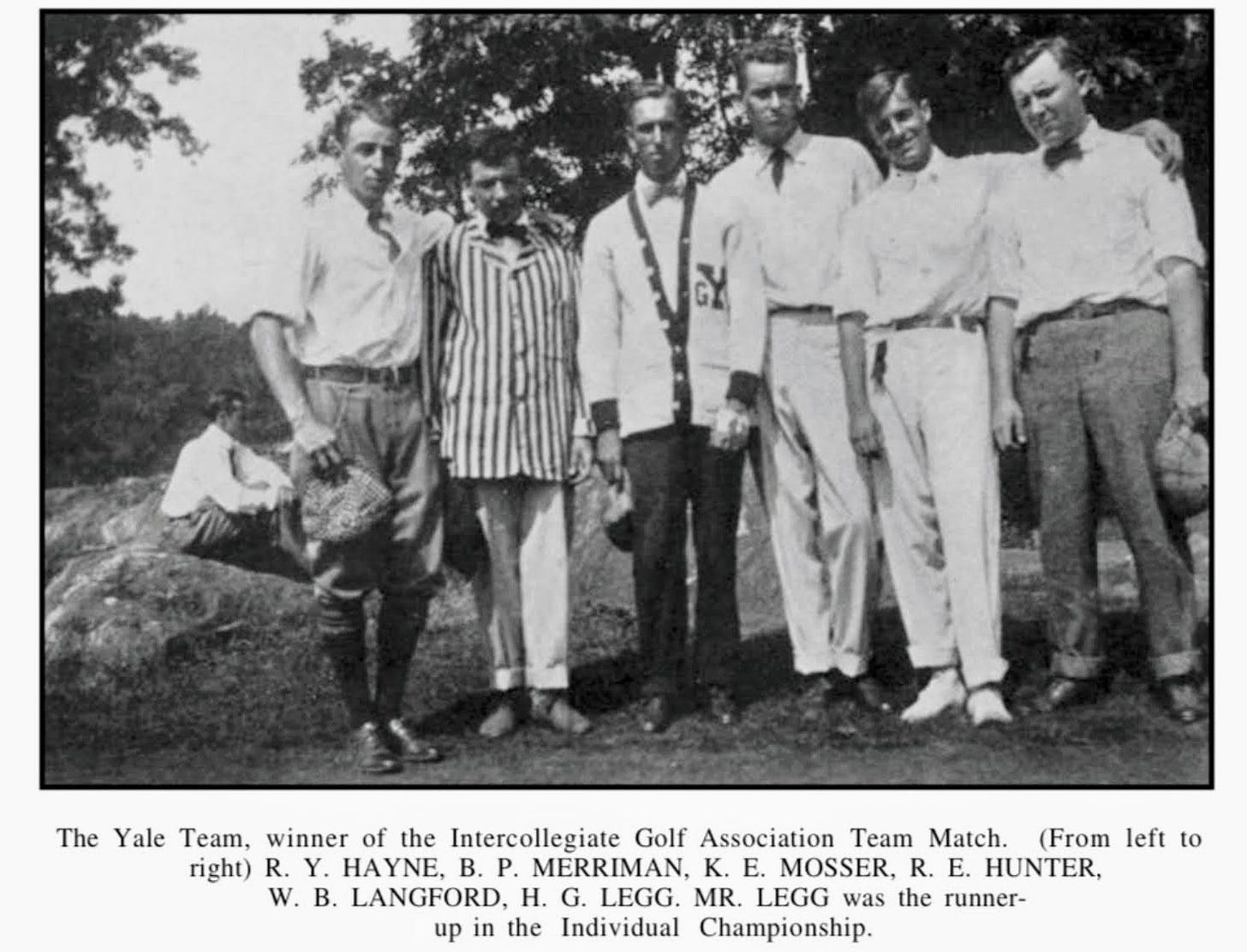
Medalist: Harry G Legg [Yale] def Buckingham P Merriman [Yale]
Last year’s runner-up Harry Legg (yes the name is real, we double-checked) tied Yale teammate and captain BP Merriman at 78. Instead of sharing medalist honors, the two had a playoff to determine the winner, which Legg won with a score of 81 to 85. What is unclear from various accounts is if the scores were taken from their respective afternoon matches or if they somehow snuck in an extra 18 holes somewhere.
Individual Champ: Robert E Hunter [Yale]
All 6 teams were represented in match play with Yale’s 7 being the most from any one team. Yale’s Robert Hunter took down the the reigning champ and clear favorite, Princeton’s Albert Seckel, while Harvard’s FC Davidson had to clear two of Hunter’s teammates on the way to the Finals.
Hunter versus Davidson was a repeat of the team Semifinals matchup which Hunter won 3&2. The individual Finals match proved to be the same result, but this time it took 39 holes, making it the second time the Finals went to extra holes (1899 Percy Pyne 2nd won in 37). On the 39th hole, Davidson topped his drive when it fell off the sand tee and it took him 3 shots to get on the green while Hunter hit a towering drive and was easily on in 2 strokes. Robert Hunter’s win gave Yale the clean sweep, the second time they had won the team title, medalist, and individual title in the same tournament (1907).
One final interesting note is that Davidson’s 93 total holes played was just one shy of the record set by the 1906 champion William Clow (Yale captain) who won matches in 21, 18, 19, and 36 holes.
Championship Award Count
EXTRA HOLES: Chick Evans (Northwestern)
Right around the time that Chandler Egan dropped off the golf map, another young Chicago-area teenager named Charles “Chick” Evans Jr burst onto the scene and won just about everything. Though not completely analogous, think of Egan as the young dominant Phil Mickelson only to have the even more dominant Tiger Woods (Evans) come along a few years later and in many ways overshadow the former. By 1910, at the age of 18, Evans had moved on from his caddying days and was already starting to hit his competitive stride, not only winning the Western Amateur (1909) but also becoming the first amateur to win the pro Western Open (1910) which was arguably equal in importance to the US Open for professionals at the time. Just six years later he would win the US Open as well as the US Amateur in the same year. Winning all four in a career - which we like to think of as the American Grand Slam - was something later equaled by Jack Nicklaus and Tiger Woods, but Evans was the only one to do so as an amateur in all four events. The only other amateur to win the Western Open, Scott Verplank (Oklahoma State), would also win the Western Am in the same year (1985) and US Am the year prior, but never won the US Open.
Evans was familiar with many of the college players, some of whom were from the Chicago area too but attending Eastern schools. One of these players was none other than Yale’s Robert Hunter who caddied for Evans the week prior at the US Amateur when he lost his semifinals match to eventual champion William C Fownes Jr, the designer and founder of Oakmont CC. Apparently, Evans stayed an extra day or two in the Boston area in order to play in the Vesper CC Open (where he medaled and set a 9 hole record) and also hoping to be able to play in the IGA individual championship which was set to begin a few days later on Sep 22nd. The two newspaper clippings from the following February outline what happened next.
The bylaws mentioned are likely a combined interpretation of sections VII and VIII from the 1900 Constitution (see below), along with Article II which states that a university team can be admitted to the IGA with a 2/3rds vote. So, although any university in the country was theoretically eligible for IGA membership, there was apparently no mechanism for allowing exceptional individual players like Chick Evans to compete; hence the WIGA (finally1) coming to fruition. . . sort of.
Keep this in mind because a decade from now a young promising Georgia Tech student named Robert Tyre “Bobby” Jones Jr. would also run into IGA restrictions.
Evans would never get his chance to play for an intercollegiate championship as financial strain would cause him to leave Northwestern by the following March (1911). With Evans’s departure from the collegiate ranks, the WIGA lost some initial steam, but would soon find a foothold with several key teams which makes it sort of a quasi-pre-Big Ten, although we do want to emphasize that because of the WWI interruption and other factors (the Western conference for football predates it) it’s not accurate to say that one became the other.
Along with his many on-course accomplishments, Evans would go on to found a scholarship program which helped young caddies realize their dream of obtaining a college education. This program first was connected exclusively with Northwestern, but would over time expand out to dozens of major universities. Chick Evans, and his scholarship program, will play a major roll in collegiate golf championships to come.
Thanks for reading!
Up Next:
In the next post we will cover the 1916 championship where you might say the fruits of Chick Evans’s efforts are realized as the first “Western” team is embraced by the IGA, along with the effort to make the championship more “national” by being held at Oakmont (PA). Also, would you have guessed that golf transfers predated WWI?
There has been talk of the Western Intercollegiate formalizing golf competition for years. The first “Western” golf match was between Michigan and Chicago in 1902 which became an annual affair for the next several years. The closest they had come to a formal tournament was a triangular meet between Michigan, Chicago, and Wisconsin in 1906 where Michigan earned some nice hardware.

